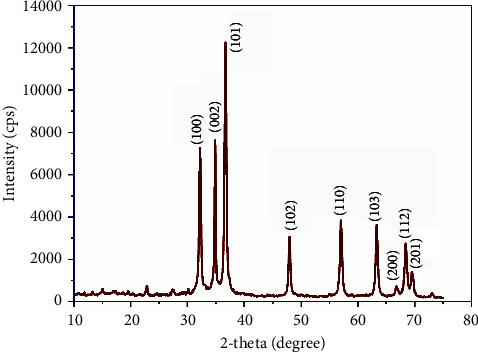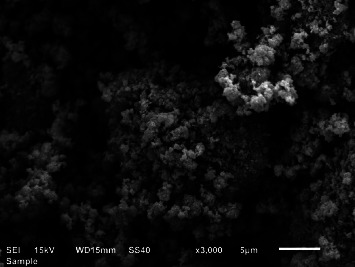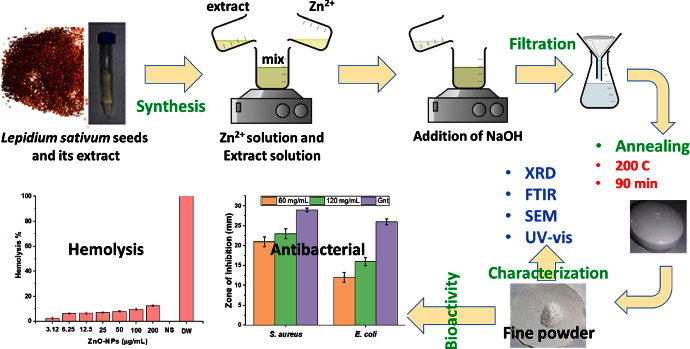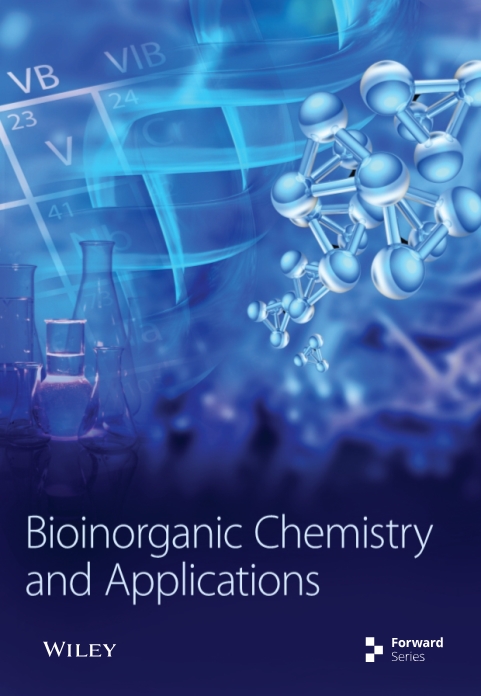蛇床子籽提取物介导氧化锌纳米粒子的合成:结构、形态、光学、溶血和抗菌研究。
IF 4.7
3区 化学
Q1 BIOCHEMISTRY & MOLECULAR BIOLOGY
Bioinorganic Chemistry and Applications
Pub Date : 2023-09-22
eCollection Date: 2023-01-01
DOI:10.1155/2023/4166128
引用次数: 0
摘要
与大块材料相比,纳米材料具有独特的物理化学性质。此外,生物合成纳米颗粒(NP)已被证明优于其他方法。本工作旨在使用蛇床子种子的水提取物生物合成氧化锌(ZnO)NPs。通过X射线衍射、扫描电子显微镜、傅立叶变换红外光谱和紫外可见光谱对所获得的ZnO纳米颗粒进行了表征。使用圆盘扩散技术评估ZnO纳米粒子对革兰氏阳性(金黄色葡萄球菌)和革兰氏阴性(大肠杆菌)细菌的体外抗菌活性。用分光光度法对溶血作用进行定量。结果显示24.2 纳米晶粒尺寸,六方结构相,3.48 eV光学带隙。抗菌研究显示出剂量依赖性反应,其活性与标准药物(庆大霉素)相当,对金黄色葡萄球菌的活性高于大肠杆菌,例如,在120 mg/mL为23 ± 1.25和16 ± 1 mm。溶血测定显示,如果低剂量使用,ZnO NP对红细胞没有潜在危害。因此,可以得出结论,所报道的合成ZnO纳米颗粒的生物方法是有前景的,从而产生血液相容性纳米颗粒和类似的杀菌剂。本文章由计算机程序翻译,如有差异,请以英文原文为准。



Lepidium sativum Seed Extract-Mediated Synthesis of Zinc Oxide Nanoparticles: Structural, Morphological, Optical, Hemolysis, and Antibacterial Studies.
Nanomaterials have unique physicochemical properties compared to their bulk counterparts. Besides, biologically synthesized nanoparticles (NPs) have proven superior to other methods. This work aimed to biosynthesize zinc oxide (ZnO) NPs using an aqueous extract of Lepidium sativum seed. The obtained ZnO NPs were characterized by X-ray diffraction, scanning electron microscopy, Fourier transform infrared, and ultraviolet-visible spectroscopy. The in vitro antibacterial activity of ZnO NPs against Gram-positive (S. aureus) and Gram-negative (E. coli) bacteria was assessed using the disk diffusion technique. The hemolytic impact was quantified spectrophotometrically. The results indicated a 24.2 nm crystallite size, a hexagonal structure phase, and a 3.48 eV optical bandgap. Antibacterial studies revealed a dose-dependent response with comparable activity to the standard drug (gentamicin) and higher activity against S. aureus than E. coli, e.g., the zone of inhibition at 120 mg/mL was 23 ± 1.25 and 16 ± 1.00 mm, respectively. The hemolysis assay showed no potential harm due to ZnO NPs toward red blood cells if utilized in low doses. As a result, it could be concluded that the reported biogenic method for synthesizing ZnO NPs is promising, resulting in hemocompatible NPs and comparable bactericidal agents.
求助全文
通过发布文献求助,成功后即可免费获取论文全文。
去求助
来源期刊

Bioinorganic Chemistry and Applications
化学-生化与分子生物学
CiteScore
7.00
自引率
5.30%
发文量
105
审稿时长
>12 weeks
期刊介绍:
Bioinorganic Chemistry and Applications is primarily devoted to original research papers, but also publishes review articles, editorials, and letter to the editor in the general field of bioinorganic chemistry and its applications. Its scope includes all aspects of bioinorganic chemistry, including bioorganometallic chemistry and applied bioinorganic chemistry. The journal welcomes papers relating to metalloenzymes and model compounds, metal-based drugs, biomaterials, biocatalysis and bioelectronics, metals in biology and medicine, metals toxicology and metals in the environment, metal interactions with biomolecules and spectroscopic applications.
 求助内容:
求助内容: 应助结果提醒方式:
应助结果提醒方式:


